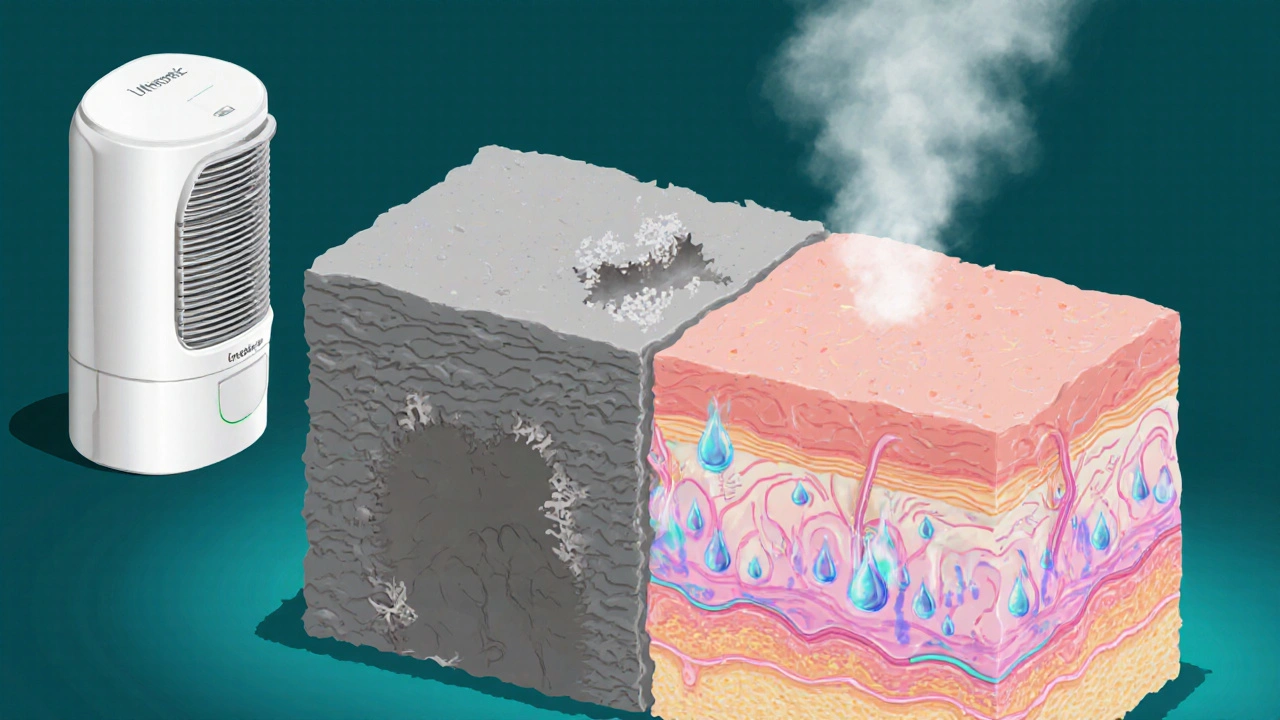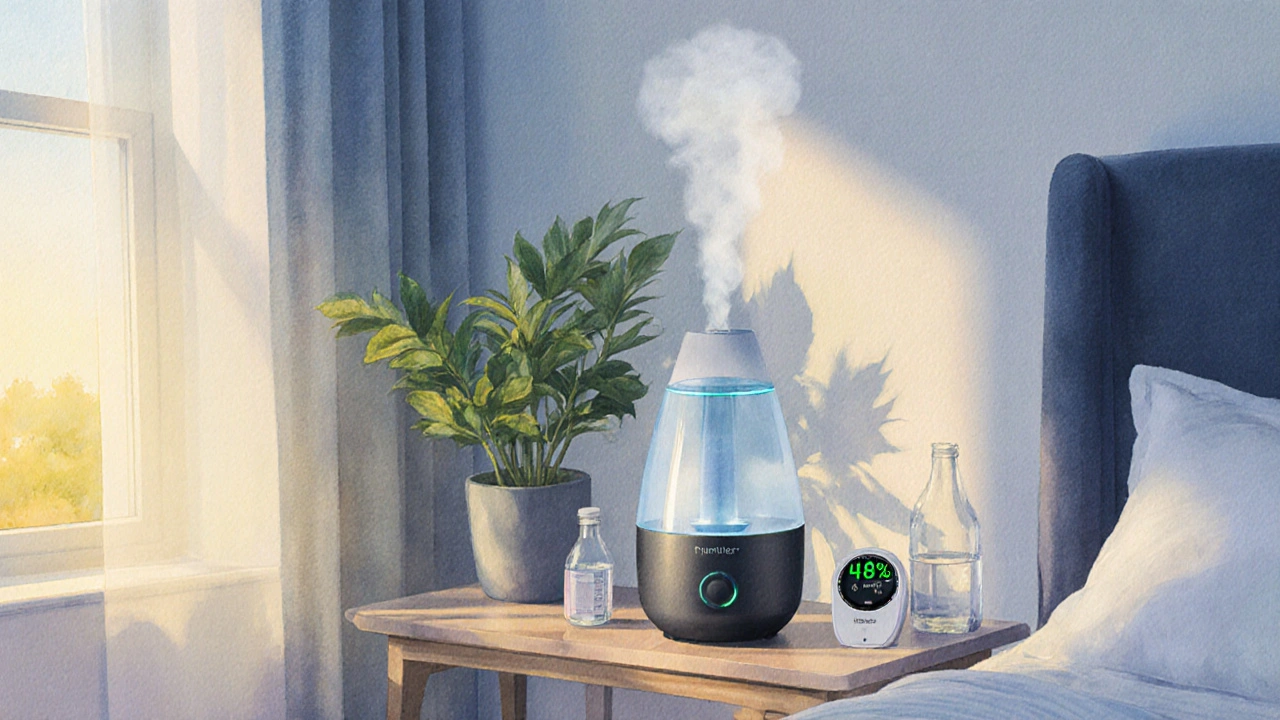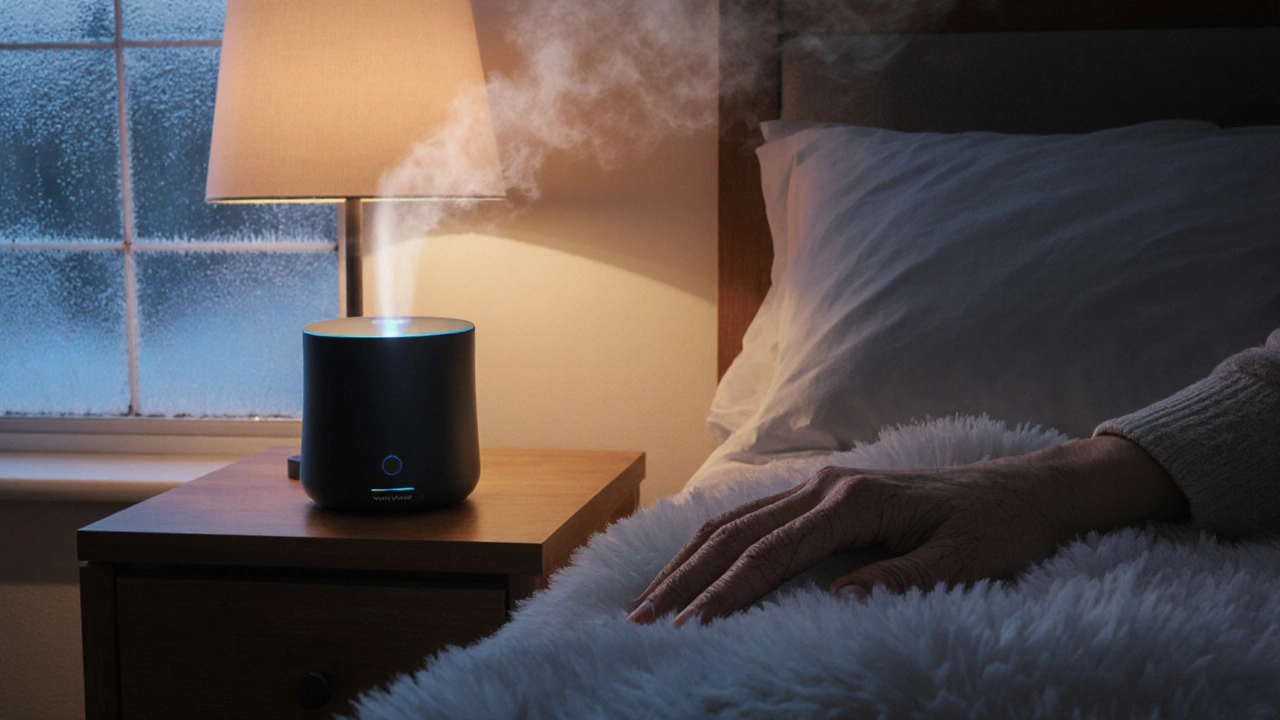Indoor Humidity Level Checker
Check Your Current Humidity Level
Enter your current indoor humidity percentage to see how it affects your skin health.
Your Humidity Status
Dry, cracked skin can feel uncomfortable and stubborn, especially when the indoor air is dry during winter or in heated rooms. A simple change in your environment - adding a humidifier for chapped skin - can make a big difference. Below we break down why moisture in the air matters, how a humidifier works, and what to look for to get the best relief.
Why Indoor Humidity Matters for Your Skin
Humidity is the amount of water vapor present in the air. When humidity drops below 30% (common in heated homes), the skin loses water faster than it can replace it, a process known as transepidermal water loss (TEWL). TEWL strips the outer skin layer, weakening the skin barrier that keeps moisture in and irritants out. The result is dry, flaky, and eventually chapped skin.
Research from the Dermatology Research Institute (2024) shows that maintaining indoor relative humidity between 40% and 60% reduces TEWL by up to 45%, allowing the skin’s natural lipids to stay intact. In practical terms, this means softer skin and fewer cracks.
How a Humidifier Helps Relieve Chapped Skin
By releasing water vapor, a humidifier raises the ambient humidity, directly lowering the gradient that drives water out of the skin. This environment supports the skin’s own repair mechanisms:
- Improved hydration: Higher humidity keeps the outermost skin cells hydrated, reducing the feeling of tightness.
- Enhanced barrier function: Moisture encourages the production of ceramides, the lipids that seal the barrier.
- Faster healing: A moist environment promotes cell turnover and reduces inflammation, speeding up the healing of cracks.
People with eczema or atopic dermatitis often notice fewer flare‑ups when they keep the indoor humidity in the optimal range, because their skin is especially sensitive to dryness.

Choosing the Right Humidifier for Your Needs
Not all humidifiers are created equal. Below is a quick comparison of the three most common types:
| Type | How It Works | Best For | Pros | Cons |
|---|---|---|---|---|
| Cool‑Mist (Evaporative) | Air passes through a wet wick, picking up moisture. | Large rooms, budget‑friendly. | Natural humidity regulation, low maintenance. | Can be noisy, wick needs regular replacement. |
| Warm‑Mist (Steam) | Water is boiled, releasing warm vapor. | Cold climates, soothing for respiratory issues. | Kills bacteria, helps with congestion. | Higher energy use, not ideal for children’s rooms. |
| Ultrasonic | Vibrating membrane creates a fine mist. | Bedrooms, quiet operation. | Very quiet, precise humidity control. | Can disperse mineral dust if using tap water. |
For most people seeking relief from chapped skin, an ultrasonic or cool‑mist unit works well. Choose a model with a built‑in hygrometer that measures the current humidity level so you can keep it in the 40‑60% range.
Setting Up Your Humidifier for Maximum Skin Benefits
- Place the unit on a flat surface at least 3feet away from walls or electronics to prevent moisture damage.
- Use distilled or demineralized water to avoid mineral buildup and white dust.
- Set the desired humidity level (40‑60%). Most modern units allow you to program this target.
- Run the humidifier for 4‑6hours a day during the driest periods (overnight and early morning).
- Clean the tank weekly with mild vinegar to prevent mold and bacteria growth.
Monitoring is key. A digital hygrometer placed in the room where you spend most time gives you an accurate readout. If humidity spikes above 65%, reduce runtime or increase ventilation to avoid mold.
Pairing Humidity with Skincare Routine
Moist air alone won’t cure severe dryness, but it amplifies the effects of good skincare:
- Apply moisturizers on damp skin: After a quick shower, pat your skin lightly and seal in moisture with a cream containing ceramides or hyaluronic acid.
- Use gentle cleansers: Harsh soaps strip natural oils, making the skin more vulnerable to dryness.
- Stay hydrated internally: Drinking 1.5‑2L of water daily supports overall skin health.
Combining a well‑maintained humidifier with these habits often yields visible improvement within a week.

Common Pitfalls and How to Avoid Them
While a humidifier is a simple tool, misuse can create new problems:
- Over‑humidification: Too much moisture encourages mold growth on walls, carpets, and even on the device itself. Keep humidity below 65%.
- Mineral dust: Using tap water in ultrasonic models can release fine minerals that settle on furniture. Switch to distilled water or use a demineralization cartridge.
- Neglecting cleaning: Stagnant water becomes a breeding ground for bacteria. Follow the weekly cleaning schedule religiously.
- Wrong placement: Putting the unit too close to electronics can cause water damage. Aim for a central location away from heat sources.
Quick Checklist for Chapped‑Skin Relief
- Choose an ultrasonic or cool‑mist humidifier with a built‑in hygrometer.
- Set indoor humidity to 40‑60%.
- Use distilled water to prevent mineral dust.
- Run the device 4‑6hours daily during dry periods.
- Clean the tank weekly with a vinegar solution.
- Apply a ceramide‑rich moisturizer on damp skin after bathing.
- Monitor humidity with a digital hygrometer and adjust as needed.
Frequently Asked Questions
Can a humidifier help eczema flare‑ups?
Yes. Maintaining indoor humidity between 40% and 60% reduces skin dryness, a common trigger for eczema. Many dermatologists recommend a cool‑mist humidifier alongside prescription moisturizers to lower flare‑up frequency.
How often should I clean my humidifier?
Ideally, empty and rinse the tank daily, then do a deep clean with a 1% white‑vinegar solution once a week. For ultrasonic models, also wipe the ultrasonic plate to prevent mineral buildup.
Is warm‑mist better for skin than cool‑mist?
Both add moisture, but warm‑mist units use heated water, which can be soothing for respiratory issues. However, they consume more energy and can slightly raise room temperature, which may not be ideal in already warm climates. For skin hydration alone, cool‑mist or ultrasonic models are generally sufficient.
What humidity level is too high?
Humidity above 65% encourages mold and dust mites. If you notice a musty smell or visible condensation on windows, lower the humidifier’s output.
Can I add essential oils to my humidifier for skin benefits?
Only if the device is labeled “essential‑oil safe.” Some ultrasonic units can disperse oils, but many manufacturers warn against it because oils can clog the mechanism and may irritate sensitive skin.


Hannah Tran
Hey there! Let me break down why a humidifier is practically a dermatological adjunct – we’re talking transepidermal water loss (TEWL), stratum corneum lipid integrity, and relative humidity (RH) optimization. When indoor RH dips below 30%, the gradient drives water out of the epidermis, destabilizing the cutaneous barrier and precipitating xerosis. By elevating RH to the 40‑60% sweet spot, a humidifier reduces that gradient, curtails TEWL, and fosters ceramide synthesis – all of which bolster barrier function. Moreover, modern units often feature built‑in hygrometers, auto‑shutdown, and antimicrobial filters, which means you get precise moisture control without the mold risk. Bottom line: if you’re battling chapped skin, a properly calibrated humidifier is a low‑cost, high‑yield intervention that synergizes with your topical regimen.
Crystle Imrie
Honestly, the article sounds like a sales pitch for a gadget nobody needs!
Shelby Rock
i guess we cant separate our skin from the air we breath, its like we are part of the atmosphere itself. when the room gets dry, our skin feels the same emptiness as a desert. it's kinda poetic that a simple mist can remind us we are not alone in this dryness. maybe the real cure is to remember we are all breathing the same air, not just slapping on creams. still, if a humidifier helps, why not give it a shot?
Dhananjay Sampath
Great post, really informative, and I appreciate the thoroughness, especially the step‑by‑step setup guide, which makes it easy for beginners, to get started without feeling overwhelmed. Just remember to keep the unit at least three feet away from walls, to prevent moisture damage, and always use distilled water, which avoids mineral buildup. Finally, regular cleaning, perhaps once a week, ensures the device stays hygienic, and your skin stays happy.
kunal ember
The relationship between ambient moisture and epidermal integrity is a classic example of environmental physiology. When relative humidity falls beneath the 30% threshold, the cutaneous stratum corneum experiences accelerated transepidermal water loss. This hyper‑gradient forces intracellular water to migrate outward, compromising lipid bilayers. Consequently, the skin barrier becomes porous, allowing irritants to infiltrate more readily. By introducing a humidifier, one effectively narrows this gradient, reducing the driving force for water efflux. Modern ultrasonic units, equipped with hygrometric feedback loops, can maintain a target humidity within a tight ±2% band. Such precision ensures that the microenvironment remains within the optimal 40–60% range cited by dermatological studies. Moreover, the consistent moisture level promotes ceramide synthesis, reinforcing the lamellar structure of the stratum corneum. Users who combine this with emollient application on damp skin report a noticeable decline in xerosis within days. It is also worth noting that excessive humidity above 65% can foster mold spores, which may exacerbate atopic conditions. Therefore, periodic monitoring with a separate digital hygrometer is advisable. Cleaning protocols, such as weekly vinegar rinses, mitigate bacterial colonization within the reservoir. Selecting distilled water eliminates mineral dust, which otherwise settles on furnishings and skin. The acoustic output of ultrasonic models is generally below 30 dB, making them suitable for bedroom use without sleep disruption. For those on a budget, evaporative cool‑mist units provide a self‑regulating mechanism, albeit with slightly higher noise levels. In summary, the strategic deployment of a properly maintained humidifier constitutes an evidence‑based adjunct to dermatologic therapy.
Kelly Aparecida Bhering da Silva
Look, the mainstream media won’t tell you this, but the real reason they push cheap humidifiers is to keep us dependent on corporate supply chains. They embed tiny sensors that report back to undisclosed “smart‑home” networks, potentially monitoring our indoor air quality and, by extension, our health habits. While they claim it’s for comfort, think about who profits when we constantly replace filters and buy “premium” distilled water. Stay vigilant, read the fine print, and consider a DIY solution that doesn’t feed into the surveillance economy.
Caley Ross
I’ve had a humidifier running in my bedroom for months, and the difference is subtle but noticeable. My skin feels less tight in the mornings, and I sleep a bit better without the dry air crackling. Just keep it clean and you’ll be fine.
Bobby Hartono
I totally agree with the idea that maintaining proper humidity is crucial for skin health, and I’d like to add a few personal observations that might help others. First, I’ve found that placing the humidifier near a nightstand, but not directly next to electronic devices, creates an even mist distribution across the room. Second, using distilled water not only prevents mineral dust but also reduces the likelihood of bacterial growth, which can be a hidden irritant for sensitive skin. Third, I set the unit to run for about five hours during the night and then a short burst in the early afternoon when the sun intensifies the dryness. Finally, pairing the humidifier with a gentle, fragrance‑free moisturizer applied to damp skin maximizes hydration retention. By following these simple steps, you’ll likely see a marked improvement in skin softness and a reduction in flakiness within a week or so.